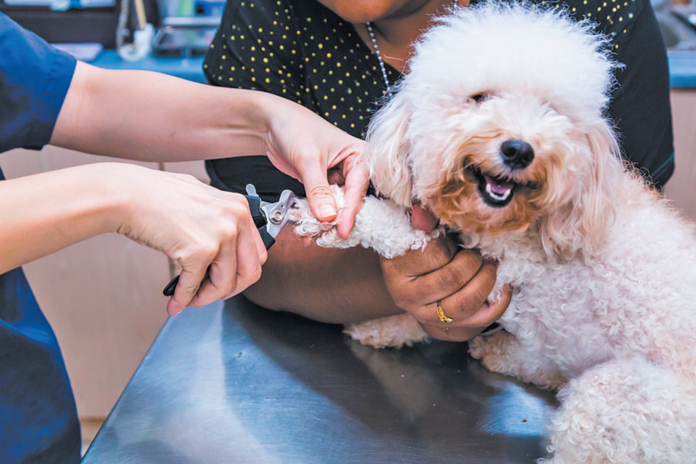Trimming your dog’s nails isn’t just about protecting your hardwood floors. Here’s what can go wrong if you don’t cut your pet’s nails regularly.
- The nails can grow into a circular shape and back into your dog’s paw pads. That doesn’t just hurt. It sometimes causes infections serious enough to turn red and ooze pus, requiring antibiotics and other medicine. We can’t tell you how many dogs we have seen in our emergency room because their nails have grown back into their paws.
- The dog can have difficulty walking on both hard and soft surfaces. Imagine trying to walk across a carpeted room with long pointy nails that keep catching on the loom — or making your way across any surface with your nails curved under and therefore interfering with the soles of your feet touching the floor.
- A nail can be ripped off if it catches on something as a dog tries to make his way past. That comes with excruciating pain.
These are the reasons we recommend that you make a habit of clipping your dog’s nails every 3 weeks. You can wait longer, perhaps until you hear your pet’s nails clicking on the floor. But if you put it on the calendar and do it every 3 weeks — or perhaps every 4 weeks if your pet spends a lot of time on concrete sidewalks or asphalt, which helps wear down the nails — you can be assured of cutting only the sharp tips. You won’t risk going further down the nail and potentially reaching the “quick.” That’s the bundle of blood and nerves at the nail root. Cutting into it causes bleeding as well as significant pain.
In people, the quick doesn’t extend into the nail. But in dogs, it reaches to about the middle. And the bleeding that ensues from cutting into it can’t always be stemmed at home; we’ve seen our share of styptic pencil “fails” in the emergency room. (Even if styptic powder does stop the bleeding, it stings — why wait too long to cut your dog’s nails and then risk that very uncomfortable solution?)
Which tool for clipping?
Three different kinds of nail clippers are good for clipping a dog’s nails.
- The first type works pretty much like a nail clipper we’d use on ourselves — although it more closely resembles a pair of pliers. It’s actually a nail snipper rather than a nail clipper. That’s just how you want it. It means you will be taking off only the sharp nail tip and not risking damage by going further along the nail.
- The second type is a tiny guillotine. You put a metal ring over the nail, and then a blade shoots out and shaves off the nail end. We find this type of clipper a bit difficult to control, but some people prefer it, and if it works better for them, it’s fine.
- The third type is not a clipper per se but a grinder. It blunts the nail tips with a little rotary sander. Some dogs prefer that method.
Important: Whichever nail clipper you use, throw it out when it dulls. Dull clippers make the nail-trimming session last longer (which no dog is going to be thrilled about). In addition, it will squeeze the nail instead of slicing it sharply. That’s yet another cause of pain. Most clippers for canines cost less than $10. (Grinders average in the neighborhood of $30.)
If you’re not the preferred manicurist
Not all dogs take well to having their nails or feet manipulated, especially if they didn’t start getting handled when the dog was a puppy. For such dogs, start by clipping just one nail a day. Each nail is a “win,” and you should reward it with a treat and enthusiastic praise.
But if even that gradual approach isn’t going to work, take your dog to the groomer’s for nail trimming. You will be preserving your bond with your pet by not engaging in an activity he doesn’t like.
If your dog has clear nails, you can actually see the quick inside them and where it ends, so it’s easier to avoid cutting into it. If your dog has dark nails, on the other hand, it’s impossible to see the quick running through. Cut just past the nail tip to avoid the quick.






Many thanks and kudos to the Tufts “Your Dog” staff and authors for featuring “A Non-Core Vaccine That May Be Critical For Your Dog: Leptospirosis cases on the rise” in the January 2023 issue. Timely and well done! Hopefully dog lovers will heed your good advice that could save many dogs from this debilitating and potentially deadly disease.